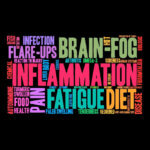Inflammation Explained

You’ve most likely heard of inflammation, but do you know exactly what it is? Well, it’s such an integral part of your body’s immune response, that it is associated with almost every health condition. In a nutshell, it’s the process your body uses to heal after an injury or to fight against viruses or bacteria. Modern medicine focusses on treating the symptoms of inflammation, but through continued training I’m discovering innovative new ways to listen to the body and interpret the cause. So, what could be inflaming your body, and what can you do to reduce it?
Acute inflammation
Let’s start by looking at inflammation in a little more detail. There are two types; the first being acute inflammation which is the healing kind. If you cut your finger, stub your toe, sprain your ankle or pick up an infection such a sore throat, your body springs into action in an attempt to repair the damage caused by the wound, or defend the virus or bacteria causing the infection. Symptoms may include redness, swelling, a temperature or moderate pain caused by white blood cells, proteins (known as cytokines which are an emergency signaller for your immune system), hormones and nutrients reacting to fix the problem. Acute inflammation is a natural process and is essential in protecting your body from harm. It’s short term and generally subsides after a few days.
Chronic inflammation
Also referred to as systemic inflammation, this is the serious one. It takes place when the body feels repeatedly threatened by something it doesn’t like. Lasting for months, or even years, it can be caused by poor diet, food sensitivities or a sedentary lifestyle. The immune system is forced to react, but with no obvious intruder the white blood cells go into self-destruct, attacking pretty much anything in sight; this can be the body’s own tissue and cells. It presents itself in ‘wear and tear’ conditions such as arthritis, as well as autoimmune diseases, bowel disease, high blood pressure and high cholesterol levels.
Signs of chronic inflammation may not be obvious, so it’s important to really listen to your body. It could be shouting from the roof tops desperate to catch your attention, but it may be calling on deaf ears.
How to spot the signs of chronic inflammation
This is a tricky one, as the list of symptoms is endless. You may be used to feeling a certain way. But, if you’re struggling with aches and pains, sore knees or shoulders, lack of energy or digestive problems such as bloating, constipation or diarrhoea it might be time to take action.
Kath’s tips on taking control of inflammation
- I would recommend trying an anti-inflammatory diet. This means cutting out refined foods such as bread, pasta, flour, cakes and biscuits etc. and enjoying fresh vegetables, fruit, pulses and proteins. There are a number of diets you can try, but The Paleo Diet is a great one to follow. Once you start to feel the benefits, of increased energy and less aches and pains, the sacrifice will be well worth it! You can then gradually introduce some of the prohibited foods and see how your body responds.
- If this is too much, why not start by introducing one new anti-inflammatory food to your diet each day; be adventurous!
- Eat foods that are high in anti-oxidants, including herbs and spices (particularly cinnamon, oregano, ginger, turmeric and rosemary) and plenty of fresh vegetables; the more colour the better!
- Fibre-richfoods are great, particularly berries like blueberries and raspberries. They are high in polyphenols (the dark pigment) which help to moderate inflammation.
- Drink plenty of filtered waterto help flush out the toxins. Green tea is also excellent.
- Vitamins C and E help reduce damage caused by inflammation. Devils Claw is good for reducing inflammation and is particularly effective for those with osteoarthritis.
- Avoid trans fats (found in cakes, biscuits and pastries etc.) and enjoy the good ones such as olive oil, avocados and 2-3 servings of cold water fish (salmon, mackerel and trout) a week.
If you are concerned about inflammation, at any level, please book an appointment to come and see me. I can work with you to identify the cause and gradually lower your inflammatory triggers, helping you to feel more like your old self.
